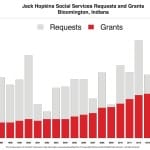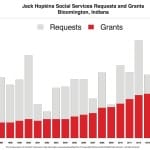Bloomington city council committee OKs start to allocation process for $311K in social services funding



In the first week of March, Bloomington area social service agencies will start receiving solicitations to apply for this year’s round of Jack Hopkins social services funding. That’s part of the schedule that the funding committee voted to adopt at its meeting last Thursday.
The $311,000 worth of funding available this year comes from the city’s general fund. That’s a $6,000 increase (about 2 percent) compared to last year. The amount gets determined each fall when the annual budget is approved.
When the fund was started in 1993, the total amount available was just $90,000. Of that, $6,363 came from raises that city council decided to turn down that year, according to Herald-Times reporting at the time.
Last year’s awards ranged from a $1,170 grant to Community Kitchen to purchase an awning and a vacuum, to a $31,456 grant to Monroe County United Ministries (MCUM) to buy fire alarm replacements.
Chair of the Jack Hopkins committee, city councilmember Susan Sandberg, described on Tuesday how Jack Hopkins funding is intended primarily to pay for things like freezers and trucks as opposed to salaries or other operational expenses. It’s a key difference between the social services funding component of federal Community Development Block Grants (CDBG) that the council approved recently, and the local Jack Hopkins funds.
But there are exceptions to the Jack Hopkins general policy against operational funding. That was one of the other pieces of business handled by the committee on Thursday—approving an allowance for operational funding, if an agency has a well-developed plan for future funding. The allowance can’t be used in consecutive years.
A third piece of business handled by the committee at its Thursday meeting was to approve an elaboration of the basic criteria for evaluating and awarding grants.
The basic criteria were first written down in a 1993 letter by councilmember Jack Hopkins, after whom the fund was named. The resolution that named the fund after Hopkins, who was a professor at the Indiana University’s public and environmental affairs, was approved by the city council in 2002, the month after Hopkins died.
The basic four criteria, from the 1993 letter by Hopkins, are:
1. The focus should be on previously identified priority areas.
2. Programs or projects should be such that a one-time investment will make a
substantial difference.
3. Priority should be given to projects or programs where investments now will
have a positive long-term spillover effect (such as reduced susceptibility to
other diseases, decreased absences from school, reducing lost time for sick
child care, etc.)
4. Capital should be leveraged wherever possible by matching from other
sources.
The Jack Hopkins committee, which is supposed to consist of five city councilmembers and two citizens, is currently short one city councilmember. At Thursday’s meeting, Sandberg said the seat will be filled once city council president Steve Volan makes the fifth appointment.
The two citizen members are Tim Mayer, a former city councilmember, and Mark Fraley, who’s associate director of Indiana University’s Political and Civic Engagement (PACE) program.
At Thursday’s meeting, Sandberg described the decisions about funding allocations as sometimes difficult. Over the years, the amount of requests has consistently outpaced the amount of funding available. Last year, the amount of requests was roughly twice the amount of grants awarded.

Sandberg described how the applicants for the funding are probably already familiar to committee members: “Many of these organizations that do apply are old hands,” she said, adding, “These are the non-profits that we know and love. We understand who they are, what they do. There’s not a lot of guess work involved.”
By the Square Beacon’s count, since 1993, 191 agencies have applied for funding from the Jack Hopkins social services fund. The top 15 recipients have received $2,647,024 (59 percent) of the $4,463,155 total allocations since 1993.

Since 2012, the committee has started to receive more applications that involve collaborations between agencies.
Eric Sader, assistant director of the city’s housing and neighborhood development department, said at Thursday’s meeting he thought it might be a trend that collaborations were more a part of the funding mix.
By the Square Beacon’s count, here’s how requests and grants for collaborations have stacked up since 2012. In four of the years (those where no gray is visible in the bar), the full amount for all collaborations was funded.

Here’s a breakdown of individual collaborations with a description of the projects:
[Direct link to Square Beacon’s Google Sheet of Jack Hopkins funding]
Applications from agencies for Jack Hopkins funds are due by March 30. The next meeting of the committee to discuss applications is April 20.




Comments ()